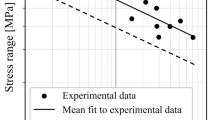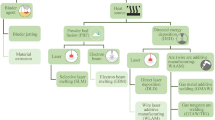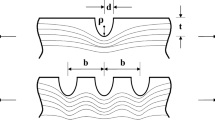Abstract
Background
Additive manufacturing (AM) is becoming increasingly popular, but standards for critical defect sizes and porosity levels have not been fully established. The wide range of flexibility offered by AM is unable to be exploited by designers if they do not have confidence in their components’ mechanical behavior.
Objective
The goal of this study was to understand how the factors of specimen geometry, geometric defects, porosity, and base material ductility impact the performance of realistic AM exemplar components.
Methods
Geometric defects, including quarter cracks, internal voids, and through holes, were intentionally manufactured into thin-walled, tapered SS 316L and AlSi10Mg AM components. Two levels of porosity were introduced by reducing the laser power in the AlSi10Mg specimens to observe interactions of porosity and the larger-scale geometric defects. Many such components were manufactured, and each component was loaded to failure.
Results
Intentionally manufactured defects decreased the failure load and displacement-to-failure for both materials. Geometric defects had a greater effect in the less ductile materials. Increasing the porosity in the AlSi10Mg above a threshold led to density-dominated component behavior, with little impact of intentional large-scale geometric defects.
Conclusions
This work demonstrated the interactions between the flaw types and the dependence of the AM component behavior based on inherent material ductility, porosity, and presence of geometric defects. The results from this study provide valuable insight for establishing a critical porosity-defect relationship for AM metals. It also demonstrates that predicting component behavior in AM metals requires an understanding of flaws types and material properties.








Similar content being viewed by others
References
Tofail SAM, Koumoulos EP, Bandyopadhyay A et al (2018) Additive manufacturing: scientific and technological challenges, market uptake and opportunities. Mater Today 21:22–37. https://doi.org/10.1016/j.mattod.2017.07.001
Liu B, Kuai Z, Li Z et al (2018) Performance Consistency of AlSi10Mg Alloy Manufactured by Simulating Multi Laser Beam Selective Laser Melting (SLM): Microstructures and Mechanical Properties. Materials (Basel). https://doi.org/10.3390/ma11122354
Geng LC, Ruan XL, Wu WW et al (2019) Mechanical Properties of Selective Laser Sintering (SLS) Additive Manufactured Chiral Auxetic Cylindrical Stent. Exp Mech 59:913–925. https://doi.org/10.1007/s11340-019-00489-0
Leach RK, Bourell D, Carmignato S et al (2019) Geometrical metrology for metal additive manufacturing. CIRP Ann - Manuf Technol. https://doi.org/10.1016/j.cirp.2019.05.004
ASTM F3049 Standard Guide for Characterizing Properties of Metal Powders Used for Additive Manufacturing Processes
ASTM F3184 Standard Specification for Additive Manufacturing Stainless Steel Alloy (UNS S31603) with Powder Bed Fusion 1. https://doi.org/10.1520/F3184-16
ASTM F3318 Standard for Additive Manufacturing-Finished Part Properties-Specification for AlSi10Mg with Powder Bed Fusion-Laser Beam 1. https://doi.org/10.1520/F3318-18
Kempen K, Thijs L, Van Humbeeck J, Kruth J-P (2012) Mechanical Properties of AlSi10Mg Produced by Selective Laser Melting. Phys Procedia 39:439–446. https://doi.org/10.1016/j.phpro.2012.10.059
Sames WJ, List FA, Pannala S et al (2016) The metallurgy and processing science of metal additive manufacturing. Int Mater Rev. https://doi.org/10.1080/09506608.2015.1116649
Olakanmi EO, Cochrane RF, Dalgarno KW (2015) A review on selective laser sintering/melting (SLS/SLM) of aluminium alloy powders: Processing, microstructure, and properties. Prog Mater Sci 74:401–477. https://doi.org/10.1016/j.pmatsci.2015.03.002
Zyguła K, Nosek B, Pasiowiec H, Szysiak N Mechanical properties and microstructure of AlSi10Mg alloy obtained by casting and SLM technique. World Sci News 104:462–472
Herzog D, Seyda V, Wycisk E, Emmelmann C (2016) Additive manufacturing of metals. Acta Mater 117:371–392. https://doi.org/10.1016/j.actamat.2016.07.019
Del Re F, Contaldi V, Astarita A et al (2018) Statistical approach for assessing the effect of powder reuse on the final quality of AlSi10Mg parts produced by laser powder bed fusion additive manufacturing. Int J Adv Manuf Technol 97:2231–2240. https://doi.org/10.1007/s00170-018-2090-y
De Pasquale G, Luceri F, Riccio M (2019) Experimental Characterization of SLM and EBM Cubic Lattice Structures for Lightweight Applications. Exp Mech 59:469–482. https://doi.org/10.1007/s11340-019-00481-8
Jiang R, Kleer R, Piller FT (2017) Predicting the future of additive manufacturing: A Delphi study on economic and societal implications of 3D printing for 2030. Technol Forecast Soc Change 117:84–97. https://doi.org/10.1016/j.techfore.2017.01.006
Taheri H, Rashid Bin M, Shoaib M et al (2017) Powder-based additive manufacturing – a review of types of defects, generation mechanisms, detection, property evaluation and metrology. Int J Addit Subtractive Mater Manuf. https://doi.org/10.1504/IJASMM.2017.088204
DebRoy T, Wei HL, Zuback JS et al (2018) Additive manufacturing of metallic components – Process, structure and properties. Prog Mater Sci 92:112–224. https://doi.org/10.1016/j.pmatsci.2017.10.001
Vastola G, Pei QX, Zhang YW (2018) Predictive model for porosity in powder-bed fusion additive manufacturing at high beam energy regime. Addit Manuf 22:817–822. https://doi.org/10.1016/j.addma.2018.05.042
Calignano F, Lorusso M, Pakkanen J et al (2017) Investigation of accuracy and dimensional limits of part produced in aluminum alloy by selective laser melting. Int J Adv Manuf Technol 88:451–458. https://doi.org/10.1007/s00170-016-8788-9
Ameta G, Lipman R, Moylan S, Witherell P (2015) Investigating the Role of Geometric Dimensioning and Tolerancing in Additive Manufacturing. J Mech Des Trans ASME 137:. https://doi.org/10.1115/1.4031296
Gao W, Zhang Y, Ramanujan D et al (2015) The status, challenges and future of additive manufacturing in engineering. Comput Des 69:65–89
Han Q, Gu H, Soe S et al (2018) Manufacturability of AlSi10Mg overhang structures fabricated by laser powder bed fusion. Mater Des 160:1080–1095. https://doi.org/10.1016/j.matdes.2018.10.043
ASTM (2018) ISO/ASTM52910 Additive manufacturing — Design — Requirements , guidelines and recommendations. In: Iso/Astm 52910:2018 (E)
ISO (2019) ISO/ASTM 52911–1:2019 - Additive manufacturing — Design — Part 1: Laser-based powder bed fusion of metals. https://www.iso.org/standard/72951.html. Accessed 30 Jun 2020
Mugica GW, Tovio DO, Cuyas JC, César González A (2004) Effect of Porosity on the Tensile Properties of Low Ductility Aluminum Alloys. Mater Res 7:221–229
Hardin RA, Beckermann C (2013) Effect of Porosity on Deformation, Damage, and Fracture of Cast Steel. Metall Mater Trans A 44:5316–5332. https://doi.org/10.1007/s11661-013-1669-z
Suresh S (2004) Fatigue of Materials. Cambridge University Press, Cambridge, Second
Ibrahim Y, Li Z, Davies CM et al (2018) Acoustic resonance testing of additive manufactured lattice structures. Addit Manuf 24:566–576. https://doi.org/10.1016/j.addma.2018.10.034
Karme A, Kallonen A, Matilainen V-P et al (2015) Possibilities of CT Scanning as Analysis Method in Laser Additive Manufacturing. Phys Procedia 78:347–356. https://doi.org/10.1016/j.phpro.2015.11.049
ASTM B311 Standard Test Method for Density of Powder Metallurgy (PM) Materials Containing Less Than Two Percent Porosity 1. https://doi.org/10.1520/B0311-17
EOS GmbH - Electro Optical Systems (2014) EOS Aluminium AlSi10Mg. In: GPI prototype Manuf. Serv.
Renishaw (2018) SS 316L-0407 powder for additive manufacturing
Yang P, Deibler LA, Bradley DR et al (2018) Microstructure evolution and thermal properties of an additively manufactured, solution treatable AlSi10Mg part. J Mater Res. https://doi.org/10.1557/jmr.2018.405
Finfrock CB, Exil A, Carroll JD, Deibler L (2018) Effect of Hot Isostatic Pressing and Powder Feedstock on Porosity, Microstructure, and Mechanical Properties of Selective Laser Melted AlSi10Mg. Metallogr Microstruct Anal 7:443–456. https://doi.org/10.1007/s13632-018-0456-z
Zakay A, Aghion E Effect of Post-heat Treatment on the Corrosion Behavior of AlSi10Mg Alloy Produced by Additive Manufacturing. J Miner Met Mater Soc. https://doi.org/10.1007/s11837-018-3298-x
Roach AM, White BC, Garland A et al (2020) Size-dependent stochastic tensile properties in additively manufactured 316L stainless steel. Addit Manuf 32:101090. https://doi.org/10.1016/j.addma.2020.101090
Salzbrenner BC, Rodelas JM, Madison JD et al (2017) High-throughput stochastic tensile performance of additively manufactured stainless steel. J Mater Process Technol 241:1–12. https://doi.org/10.1016/j.jmatprotec.2016.10.023
Brandl E, Heckenberger U, Holzinger V, Buchbinder D (2012) Additive manufactured AlSi10Mg samples using Selective Laser Melting (SLM): Microstructure, high cycle fatigue, and fracture behavior. Mater Des 34:159–169. https://doi.org/10.1016/j.matdes.2011.07.067
Li W, Li S, Liu J et al (2016) Effect of heat treatment on AlSi10Mg alloy fabricated by selective laser melting: Microstructure evolution, mechanical properties and fracture mechanism. Mater Sci Eng A 663:116–125. https://doi.org/10.1016/j.msea.2016.03.088
Uzan NE, Shneck R, Yeheskel O, Frage N (2017) Fatigue of AlSi10Mg specimens fabricated by additive manufacturing selective laser melting (AM-SLM). Mater Sci Eng A 704:229–237. https://doi.org/10.1016/j.msea.2017.08.027
Yang P, Rodriguez MA, Deibler LA, et al (2019) Effect of thermal annealing on microstructure evolution and mechanical behavior of an additive manufactured AlSi10Mg part. https://doi.org/10.1557/jmr.2018.82
Han Q, Jiao Y Effect of heat treatment and laser surface remelting on AlSi10Mg alloy fabricated by selective laser melting. https://doi.org/10.1007/s00170-018-03272-y
Zhuo L, Wang Z, Zhang H et al (2019) Effect of post-process heat treatment on microstructure and properties of selective laser melted AlSi10Mg alloy. Mater Lett 234:196–200. https://doi.org/10.1016/j.matlet.2018.09.109
Anderson TL (2005) Fracture Mechanics - Fundamentals and Applications, 3rd Ed. CRC Press
William D. Callister J, David G. Rethwisch (2009) Material Science And Engineering An Introduction
Wilson-Heid AE, Novak TC, Beese AM (2019) Characterization of the Effects of Internal Pores on Tensile Properties of Additively Manufactured Austenitic Stainless Steel 316L. Exp Mech 793–804. https://doi.org/10.1007/s11340-018-00465-0
Yegyan Kumar A, Wang J, Bai Y et al (2019) Impacts of process-induced porosity on material properties of copper made by binder jetting additive manufacturing. Mater Des 182:108001. https://doi.org/10.1016/j.matdes.2019.108001
Acknowledgements
The authors would like to thank Todd Huber for his assistance in fixturing. The help and advice from David Saiz in additively manufacturing is also appreciated. Finally, we would like to thank Dr. Amanda Jones for the helpful review and discussions. This research was funded through the Laboratory Directed Research & Development (LDRD) office. Sandia National Laboratories is a multimission laboratory managed and operated by National Technology and Engineering Solutions of Sandia LLC, a wholly owned subsidiary of Honeywell International Inc. for the U.S. Department of Energy’s National Nuclear Security Administration under contract DE-NA0003525.
Author information
Authors and Affiliations
Corresponding author
Ethics declarations
Conflict of Interest
The authors declare that they have no conflict of interest.
Rights and permissions
About this article
Cite this article
Smith, B.A., Laursen, C.M., Bartanus, J. et al. The Interplay of Geometric Defects and Porosity on the Mechanical Behavior of Additively Manufactured Components. Exp Mech 61, 685–698 (2021). https://doi.org/10.1007/s11340-021-00696-8
Received:
Accepted:
Published:
Issue Date:
DOI: https://doi.org/10.1007/s11340-021-00696-8




